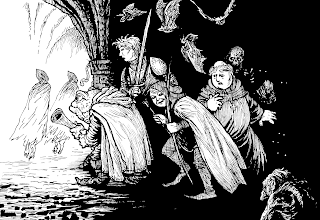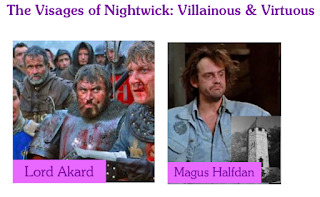 |
| Swine Chopper from Darkest Dungeons |
Once again I am surprised by what catches fire on Twitter and what doesn't. The most recent example is a response I posted to Luke Gearing and Sean McCoy's tweets about simple monster design. I agree with both in that it shouldn't be too complicated, but you do need some variation. To achieve that, I use a sort of "Punnett's square" based on [melee or range] x [dmg or special].
I created this method when trying to figure our how to further differentiate all the various factions in Forbidden Caverns of Archia. This megadungeon module has several factions that players interact with and I wanted to given them both a distinctive feel and strategic/tactical pros and cons. That way PCs could make informed decisions, based on their own party compositions, of who to interact with and tactics to use.Here the basic Punnett's Square outline and below I will explain (1) how I envision each quadrant, (2) how this tool can be scaled to a small force, a singular "boss" monster, or a whole dungeon level, and (3) provide some examples.
 |
| The very basic square & you most likely get it already. |
I. Characteristics Of Each Quadrant
- melee x damage: Enemies are characterized by how much damage they inflict and the melee weapons they use to do it: sword, axe, mace, or claws. The rank and file of an army or faction. The very basic unit.
Generally I keep the damage to whatever weapon you use to define the melee "class". If in your game weapons have different qualities, such as in Luke Gearing's Wolves Upon the Coast, all the better. This might also be a could place to add an additional attack. - melee x special: For the exercise, I try to keep the damage at a 1d6 level but try to think of either (1) some unique way to deliver damage; (2) some unique effect on a successful melee hit in addition to the damage (which is why its kept low); (3) some spell-like effect that changes things while in melee. This quadrant might also include "attack animals" the (melee x damage) units might use.
Now, since you are often running monsters in aggregate, I'd stick to just *one* additional effect and at the most two. This is because too many effects takes up DM brain-space.
Examples:
- Too quick!: Creature always attacks before PC
- Charge: Creature moves in a straight-line anyone in between Save vs. Paralysis or take 1d6
- Heavy hands: On a successful hit, save vs. paralysis or PC is knocked prone
- Duelist: On a dmg roll of 1, save vs. paralysis or PC has weapon knocked from hand (may choose shield)
- Grisly visage: Creaure has a 5' aura of fear
- Mirrored image: Hard to focus on the true creature, first X attacks automatically miss
- Trog stench: Foul stench makes it hard to hit
- Spiky: Take 1 damage per round engaged in melee with the creature (pretty classic)
- Web: Creature entangle on a successful melee (also pretty classic)
- range x damage: Another basic rank-and-file unit armed with missile weapons. I also include reach weapons in this quadrant like the ever-useful spear. Other mundane sources of missile fire could be the old oil+torch or flaming arrows. Or it could be (melee X damage) units that first engage with 1 or 2 javelins before pulling out swords.
For a touch more flavor, I might also just put very basic magic-users here with magic-missile-like attacks or ranged elemental damage. Could also be interesting reach weapons like a giant scorpion tail whip.
For the armor of these units, I drop it 1 or 2 points below the (melee X damage) units and also give them a 1d4 melee weapon of last resort. However, if you wanted to express that what players are facing is a well-run military machine, these (range x damage) might just convert into (melee x damage) once the distance is closed. - range x special: When filling out this quadrant, I often don't even think about damage at all (but I don't exclude it). I am often trying to come up with fun, interesting, and thematic area effects (mundane or magical). And creatures with more spell-like effects that give boons and/or banes to friend and foe alike.
Examples: - Fetid air: A creature carries a censer that casts fog or darkness
- Standard bearer: A unit carries a banner that carries a magical effect or boosts morale
- Dance of the dead: A creature can raise any dead on the battlefield or beats a drum that causes the dead to rise on a 5:6 every round
- Anti-magic eye: a creature has a Beholder central eye on a stick directed toward magic-users
- Spider climb archers: creature can climb walls/ceiling and fire from there
- Shadow hands: The unit produces large, but clumsy hands from the corner shadows to grab
 |
| The punnett's square for kobold |
- melee x damage: 1d10 (pretty standard) but maybe the front half is better armored AC +2
- melee x special: Since 2x1d10 damage is already strong how about "if hit, can crush for 1d6 damage per round, STR to escape claw"
- range x damage: Stinging tail with 10' reach
- range x special :
- (v1): Again, since we already have 3 attacks, how about "can throw PC hit with claw 15' 1d6 damage if they hit another PC or solid object
- (v2): Summon a swarm of insects to surround any target in line of sight; 1:4 drop weapon or disrupt spell casting














